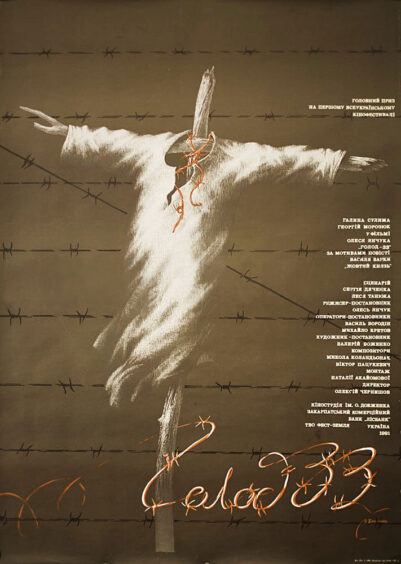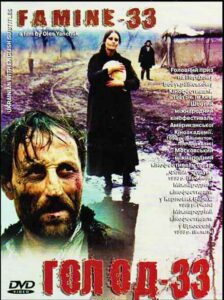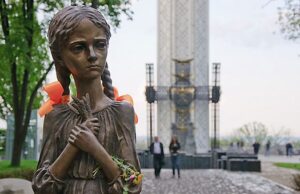 A 1991 film that (for reasons that will become obvious) took on an entirely new resonance in the 2020s. It’s a chronicle of the Holodomor, or Artificial Famine, that afflicted Ukraine in 1932-33, engineered by Joseph Stalin to (it’s been claimed) crush Ukrainian resistance to Soviet rule. Brought about by outrageously high grain quotas, the famine had a death toll that has been estimated at 2-5 million, yet it went (deliberately) unmentioned in the Soviet Union for many decades. That explains why this film, based on a 1963 novel by Vasyl Barka, took until 1991 to be made (subsequent filmic attempts at dramatizing the Holodomor include 2017’s BITTER HARVEST and 2019’s MR. JONES).
A 1991 film that (for reasons that will become obvious) took on an entirely new resonance in the 2020s. It’s a chronicle of the Holodomor, or Artificial Famine, that afflicted Ukraine in 1932-33, engineered by Joseph Stalin to (it’s been claimed) crush Ukrainian resistance to Soviet rule. Brought about by outrageously high grain quotas, the famine had a death toll that has been estimated at 2-5 million, yet it went (deliberately) unmentioned in the Soviet Union for many decades. That explains why this film, based on a 1963 novel by Vasyl Barka, took until 1991 to be made (subsequent filmic attempts at dramatizing the Holodomor include 2017’s BITTER HARVEST and 2019’s MR. JONES).
The debut feature of Oles Yanchuk (coming off the award-winning 1989 short TAKING OFF/U daleku Put), FAMINE ‘33 (Holod-33) was made with commercial funding, independently of the Soviet state. For that and other reasons Russia has done its best to pretend that FAMINE ‘33 doesn’t exist, even as the film has been broadcast annually on Ukrainian television.
It begins in the winter of 1933, with a church service being disrupted by Stalinists. This inspires a mad rush by the congregants to grab up all the valuables, including a large golden chalice that ends up buried under a tree.
Next we see a family harassed by soldiers who take away the food stores, as it’s been decreed that 90 percent of all food in Ukraine must go to the state. In short order the family’s oldest member (Neonila Svetlichnaya) dies, and the patriarch Myron (Georiy Morozyuk) is tortured by Soviet authorities wanting to know the location of the chalice.

In the surrounding countryside, meanwhile, a man is found cannibalizing the corpse of his son, children are kidnapped and suicide becomes increasingly commonplace. There’s a march on the Soviet military stronghold to beg for flour, which ends in a massacre, and the family whose fortunes we’ve been following comes completely unglued as the matriarch Dariya (Galina Sulima) is killed for a loaf of bread as her son Andrey (Maksym Koval) wanders the forbidding wilderness, screaming for his mother.
In truth this is a clumsy and amateurish film, with uncertain pacing, overly literal nuance-free dialogue, out-of-place synthesizer music, stilted acting and visuals that haphazardly switch back and forth (Tarkovsky-like) from color to black and white. Stylistically, however, it’s a tour de force, with a naturalistic veneer that gradually gives way to the type of impressionistic filmmaking that typified the Ukrainian Poetic Cinema movement of Sergei Paradjanov and Yuri Ilyenko.
The physical details of the production, in which impossibly bleak and forbidding snowbound landscapes are dotted with scattered corpses, and people both alive and dead are tossed into a massive fire pit, are undeniably impacting, and leave us with a viewing experience that impacts the viewer greatly. Pleasant this film may not be, but necessary it is.
Vital Statistics
FAMINE ’33 (Holod-33)
Fest Zemlya/Lesbank
Director: Oles Yanchuk
Producer: Oleksiy Chernishov
Screenplay: Serhiy Dyachenko, Les Taniuk
(Based on a novel by novel by Vasyl Barka)
Cinematography: Vasyl Borodin, Mykhailo Kretov
Cast: Halyna Sulyma, Heorhiy Moroziuk, Oleksiy Gorbunov, Maksym Koval, Olenka Kovtun, Kostyantyn Kazymirenko, Neonila Svitlychna, Leonid Yanovsky, Petro Beniuk, Leo Okrent, Oleh Isayev, Tetiana Slobidska, Svetlana Romashko, Larysa Kadyrova, Alidzhan Soluyan

